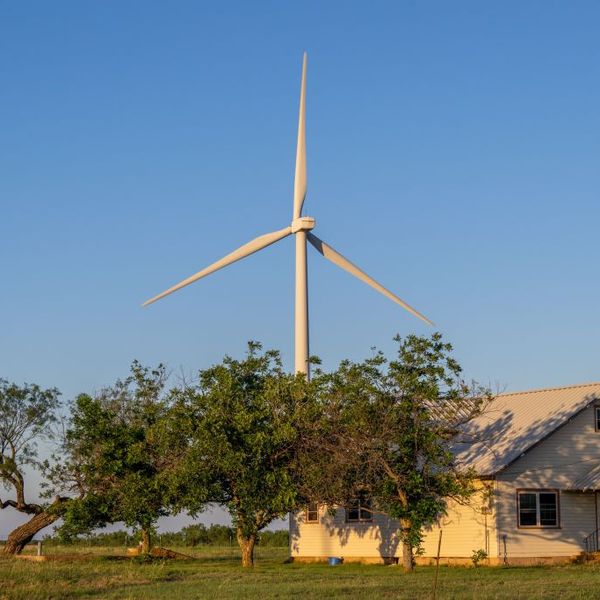
An ENGIE employee walks past solar panels at the ENGIE Sun Valley Solar project in Hill County, Texas, on March 1, 2023.
Analysts Say Solar Is Saving Texans From Widespread Power Outages Amid Extreme Heat
"Renewables are definitely saving the grid and saving our wallets," said one independent energy analyst.
A sweltering heatwave has gripped Texas over the last two weeks, pushing temperatures to 115°F in parts of the state—but its status as a new leader in the development of solar power has reportedly protected many in the state from a catastrophic loss of power.
An intense heat dome—in which an area of high pressure traps heat underneath it—has settled over northern Mexico and is expected to persist next week and potentially beyond, likely causing the heat index to reach high into the 100s across Texas and top 120° in the southern part of the state in the coming days.
Extreme weather has placed millions of Texans in harm's way before, notably during a winter storm in February 2021 that plunged much of the state into a prolonged blackout when natural gas power plants faced outages, as a federal review later found—contrary to claims by Republican Gov. Greg Abbott that the state's wind turbines failed residents by freezing.
But this month, reported The New York Times on Friday, "the lights and air conditioning have stayed on across the state," and analysts have linked the continuation of power to Texas's doubling of the amount of solar energy it's generated since early 2022.
While Texas has built its reputation in recent decades as a center of oil and gas production in the U.S., "solar is producing 15% of total energy right now," University of Texas research scientist Joshua Rhodes told the Times. The state now leads the nation in renewable energy, with 17 gigawatts of solar power operational this year.
"They have this narrative that they push that they need more dispatchable power plants and need more gas plants. It's a very politically driven narrative by many of the state leaders."
The amount of solar power produced in the state is expected to double again by the end of 2024, according to the Electric Reliability Council of Texas.
Doug Lewin, president of clean energy consulting firm Stoic Energy in Austin and host of the Texas Power Podcast, told Inside Climate News on Friday that Republican leaders in Texas aren't likely to acknowledge that the state's solar power boom is helping residents to avoid blackouts.
"They have this narrative that they push that they need more dispatchable power plants and need more gas plants," he told the outlet. "It's a very politically driven narrative by many of the state leaders."
The GOP-controlled Texas Legislature passed a $10 billion program to incentivize new natural gas power plant development last month, and recently made an unsuccessful attempt to pass new permitting requirements and restrictions for renewable energy producers.
As Republican lawmakers remain committed to promoting the very energy sources that are fueling the climate emergency—and making extreme heatwaves like the one enveloping Texas five times more likely to occur, an analysis of federal data showed earlier this month—Lewin noted this week that fossil fuel-powered plants have been struggling to provide energy amid the heat.
"Renewables are definitely saving the grid and saving our wallets," Alison Silverstein, an independent energy consultant based in Austin, told the Times on Friday.
Energy demand next week is likely to reach record levels in Texas as the Gulf Coast is expected to see temperatures of "at least 110°F every day," according to the National Weather Service.
An Urgent Message From Our Co-Founder
Dear Common Dreams reader, The U.S. is on a fast track to authoritarianism like nothing I've ever seen. Meanwhile, corporate news outlets are utterly capitulating to Trump, twisting their coverage to avoid drawing his ire while lining up to stuff cash in his pockets. That's why I believe that Common Dreams is doing the best and most consequential reporting that we've ever done. Our small but mighty team is a progressive reporting powerhouse, covering the news every day that the corporate media never will. Our mission has always been simple: To inform. To inspire. And to ignite change for the common good. Now here's the key piece that I want all our readers to understand: None of this would be possible without your financial support. That's not just some fundraising cliche. It's the absolute and literal truth. We don't accept corporate advertising and never will. We don't have a paywall because we don't think people should be blocked from critical news based on their ability to pay. Everything we do is funded by the donations of readers like you. Will you donate now to help power the nonprofit, independent reporting of Common Dreams? Thank you for being a vital member of our community. Together, we can keep independent journalism alive when it’s needed most. - Craig Brown, Co-founder |
A sweltering heatwave has gripped Texas over the last two weeks, pushing temperatures to 115°F in parts of the state—but its status as a new leader in the development of solar power has reportedly protected many in the state from a catastrophic loss of power.
An intense heat dome—in which an area of high pressure traps heat underneath it—has settled over northern Mexico and is expected to persist next week and potentially beyond, likely causing the heat index to reach high into the 100s across Texas and top 120° in the southern part of the state in the coming days.
Extreme weather has placed millions of Texans in harm's way before, notably during a winter storm in February 2021 that plunged much of the state into a prolonged blackout when natural gas power plants faced outages, as a federal review later found—contrary to claims by Republican Gov. Greg Abbott that the state's wind turbines failed residents by freezing.
But this month, reported The New York Times on Friday, "the lights and air conditioning have stayed on across the state," and analysts have linked the continuation of power to Texas's doubling of the amount of solar energy it's generated since early 2022.
While Texas has built its reputation in recent decades as a center of oil and gas production in the U.S., "solar is producing 15% of total energy right now," University of Texas research scientist Joshua Rhodes told the Times. The state now leads the nation in renewable energy, with 17 gigawatts of solar power operational this year.
"They have this narrative that they push that they need more dispatchable power plants and need more gas plants. It's a very politically driven narrative by many of the state leaders."
The amount of solar power produced in the state is expected to double again by the end of 2024, according to the Electric Reliability Council of Texas.
Doug Lewin, president of clean energy consulting firm Stoic Energy in Austin and host of the Texas Power Podcast, told Inside Climate News on Friday that Republican leaders in Texas aren't likely to acknowledge that the state's solar power boom is helping residents to avoid blackouts.
"They have this narrative that they push that they need more dispatchable power plants and need more gas plants," he told the outlet. "It's a very politically driven narrative by many of the state leaders."
The GOP-controlled Texas Legislature passed a $10 billion program to incentivize new natural gas power plant development last month, and recently made an unsuccessful attempt to pass new permitting requirements and restrictions for renewable energy producers.
As Republican lawmakers remain committed to promoting the very energy sources that are fueling the climate emergency—and making extreme heatwaves like the one enveloping Texas five times more likely to occur, an analysis of federal data showed earlier this month—Lewin noted this week that fossil fuel-powered plants have been struggling to provide energy amid the heat.
"Renewables are definitely saving the grid and saving our wallets," Alison Silverstein, an independent energy consultant based in Austin, told the Times on Friday.
Energy demand next week is likely to reach record levels in Texas as the Gulf Coast is expected to see temperatures of "at least 110°F every day," according to the National Weather Service.
- Greg Casar Drafting Bill to Connect Texas to National Electric Grids ›
- Opinion | A Full-Court Press for Renewables Will Save Money and the Planet | Common Dreams ›
A sweltering heatwave has gripped Texas over the last two weeks, pushing temperatures to 115°F in parts of the state—but its status as a new leader in the development of solar power has reportedly protected many in the state from a catastrophic loss of power.
An intense heat dome—in which an area of high pressure traps heat underneath it—has settled over northern Mexico and is expected to persist next week and potentially beyond, likely causing the heat index to reach high into the 100s across Texas and top 120° in the southern part of the state in the coming days.
Extreme weather has placed millions of Texans in harm's way before, notably during a winter storm in February 2021 that plunged much of the state into a prolonged blackout when natural gas power plants faced outages, as a federal review later found—contrary to claims by Republican Gov. Greg Abbott that the state's wind turbines failed residents by freezing.
But this month, reported The New York Times on Friday, "the lights and air conditioning have stayed on across the state," and analysts have linked the continuation of power to Texas's doubling of the amount of solar energy it's generated since early 2022.
While Texas has built its reputation in recent decades as a center of oil and gas production in the U.S., "solar is producing 15% of total energy right now," University of Texas research scientist Joshua Rhodes told the Times. The state now leads the nation in renewable energy, with 17 gigawatts of solar power operational this year.
"They have this narrative that they push that they need more dispatchable power plants and need more gas plants. It's a very politically driven narrative by many of the state leaders."
The amount of solar power produced in the state is expected to double again by the end of 2024, according to the Electric Reliability Council of Texas.
Doug Lewin, president of clean energy consulting firm Stoic Energy in Austin and host of the Texas Power Podcast, told Inside Climate News on Friday that Republican leaders in Texas aren't likely to acknowledge that the state's solar power boom is helping residents to avoid blackouts.
"They have this narrative that they push that they need more dispatchable power plants and need more gas plants," he told the outlet. "It's a very politically driven narrative by many of the state leaders."
The GOP-controlled Texas Legislature passed a $10 billion program to incentivize new natural gas power plant development last month, and recently made an unsuccessful attempt to pass new permitting requirements and restrictions for renewable energy producers.
As Republican lawmakers remain committed to promoting the very energy sources that are fueling the climate emergency—and making extreme heatwaves like the one enveloping Texas five times more likely to occur, an analysis of federal data showed earlier this month—Lewin noted this week that fossil fuel-powered plants have been struggling to provide energy amid the heat.
"Renewables are definitely saving the grid and saving our wallets," Alison Silverstein, an independent energy consultant based in Austin, told the Times on Friday.
Energy demand next week is likely to reach record levels in Texas as the Gulf Coast is expected to see temperatures of "at least 110°F every day," according to the National Weather Service.
- Greg Casar Drafting Bill to Connect Texas to National Electric Grids ›
- Opinion | A Full-Court Press for Renewables Will Save Money and the Planet | Common Dreams ›

